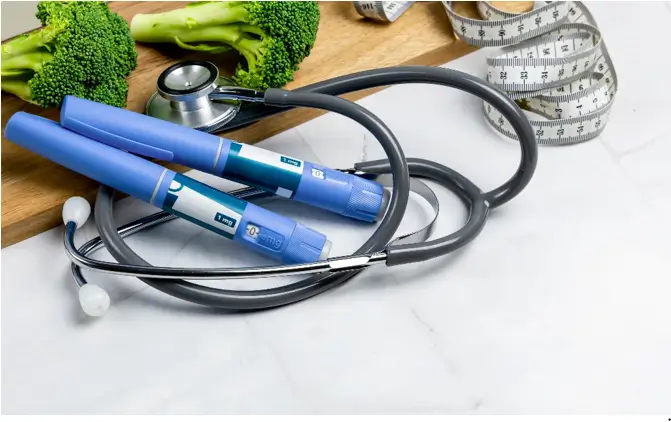How We Use GLP-1 Matters
It is not the tool; it is how you use it. The class of obesity medications that focus on GLP-1 and GIP are powerful tools for weight loss. They are not panacea and not a guarantee of weight loss success. Even more importantly when it comes to health, weight is a poor biomarker of health and vitality. Here is where HOW we use anti-obesity medications matters.
Samantha came in for evaluation after having been on Semaglutide at the maximum dose for one year. She found the medication helped her lose weight, but she was stuck, and her goal weight was still 30 lbs. away and she really had hit a plateau. She was eating much less at each meal but not really paying attention to the quality of her diet. She was experiencing other symptoms such as hair loss and a depressed mood. She was happy with the weight she had lost but was disappointed after a year she was not at her goal weight.
The Less You Eat, The More Important the Quality of the Food You Are Eating
Food is energy. Food is nourishment and nutrients- not just calories. Our bodies assimilate what is in our food to power our cellular energy processes, make hormones and repair tissue. The cellular signaling that occurs when we eat the food differs based on the composition of the food. Remember the saying “You are What You Eat” – there is truth in that. There are no doubt medications such as semaglutide and tirzepatide dramatically reduce the volume of the food we are eating. However, our cells and our body – everything from the immune system to the hormone system to energy production – all require nutrients. Optimal function depends on the availability of vitamins and minerals, fatty acids, and amino acids.
You can be successful with weight reduction on pharmaceuticals but sometimes at a cost of optimal body function and lean body mass. How you use these tools have influence.
Using weight loss medications to work on the habits and diet quality will set you up for success long term and for optimizing health.
When we reviewed Samantha’s diet, we realized she was not eating the right kinds of foods to help her health flourish. She would start her day with a cup of coffee and sometimes a piece of toast. Lunch was often on the go, half of a fast-food meal or a protein bar and then dinner was usually at home with her family, often some type of meat along with a vegetable and starch. She would often find herself just picking as she cooked and then when she sat down to eat would just have a small portion.
Samantha’s body composition showed low muscle mass and still a high percentage of her weight was fat mass.
It starts with the mindset of food as fuel and nourishment. For the longest time food was the enemy. Helping Samatha think about fuel as nourishment for her body was a big first step. She started swapping the toast for a protein smoothie in the morning. She bought salad greens and rotisserie chicken to put on her greens for lunch. She learned to prioritize sitting down to eat her meal at dinner – to taste her food and eat slowly and mindfully.
Samatha realized that the foods she was choosing helped her feel more satisfied. Where normally she felt as the week went on after her injection the “food noise” slowly came back – that was no longer the case. She started to create new habits around her eating pattern. After evaluating her micronutrients and realizing she was deficient in several vitamins and minerals, she added a multivitamin, vitamin D and omega three fatty acids (fish oil) to daily regimen. Her mood started to improve, and her weight loss started to pick up again even though we did not change the medication. She stopped losing her hair.
Reducing loss of lean body mass.
Exercise also plays a role in preventing loss of lean body mass. We think that calories in – calories out are effective in weight loss success. But when it comes to losing fat mass and retaining or building muscle, exercise plays a big role.
Samantha was not making her exercise a priority. Initially she felt she did not have to as the numbers on the scale were going down. We realized that her muscle mass had gone down over the last year. When our muscle mass is low, our metabolic rate also slows down (how many calories we burn at rest). This is why Samantha was not eating a lot of calories but was not losing weight. Starting to do strength training and some interval training for cardiovascular exercise really was efficient. We started to see her muscle mass increase and fat mass dramatically started to go down in combination with dietary changes.
Creating habits as a set up for long term success. Pharmaceuticals for weight loss help us sustain low caloric intake consistently over time. Maintenance of remission though takes a shift in our mindset and in our daily routine when it comes to food and exercise. Our bodies make GLP-1 and GIP hormones naturally. The quality of what we eat influences natural production.
Best practice is using the medications to allow for consistency and habit building over time to set the stage for a maintenance lifestyle plan.
References:
Wadden TA, Chao AM, Moore M, Tronieri JS, Gilden A, Amaro A, Leonard S, Jakicic JM. The Role of Lifestyle Modification with Second-Generation Anti-obesity Medications: Comparisons, Questions, and Clinical Opportunities. Curr Obes Rep. 2023 Dec;12(4):453-473. doi: 10.1007/s13679-023-00534-z. Epub 2023 Dec 2. PMID: 38041774; PMCID: PMC10748770.





